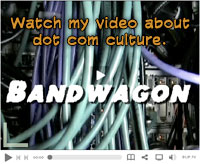The Lost Art of Sketching
 I've been working with computers, lo these last 20 years. I've always gravitated toward the crowd that liked pencils with their digital tools. I've been an advocate of the low-fidelity prototype since the early days. As an Internet industry worker, I recommend drawing in a journal/sketchbook at least a few times a week. Lately I've forced myself to do it every day. The results are extremely beneficial to me...I work out problems conceptually before I implement them in my professional life. Plus, it's just therapeutic to draw a dragon, skull or robot at least once a day.
I've been working with computers, lo these last 20 years. I've always gravitated toward the crowd that liked pencils with their digital tools. I've been an advocate of the low-fidelity prototype since the early days. As an Internet industry worker, I recommend drawing in a journal/sketchbook at least a few times a week. Lately I've forced myself to do it every day. The results are extremely beneficial to me...I work out problems conceptually before I implement them in my professional life. Plus, it's just therapeutic to draw a dragon, skull or robot at least once a day.




Please see some of my recent sketchbook doodles by clicking on the thumbnails above. I've removed most of the text and words, but I wanted to collect these pen & pencil sketches in a digital way. I also posted them to my Flickr page. If you have a Flickr account, you can see the super hi-res versions of these.
It seems sketching is enduring a bit of a resurgence. Sketching comes back into fashion. I love it. Below are some examples of these concepts.
For ages, people in power have used simple pens and pencils to work out complex problems. Check out the great book called Presidential Doodles: Two Centuries of Scribbles, Scratches, Squiggles, and Scrawls from the Oval Office
The Back of the Napkin by Dan Roam is a fun, prescriptive book which helps you "solve any problem with a picture".
Sketching User Experiences: Getting the Design Right and the Right Design
Learn about mind mapping, graphic facilitation and sketchnoting in the great post, "The Joy of Sketch: explorations in hand-crafted visuals" by Kate Rutter of Adaptive Path.
LISTEN: Hear the NPR story "Bored? Try Doodling To Keep The Brain On Task" by Alix Spiegel. There are also some of President Obama's doodles on the website.
Next year, don't forget National Doodle Day.
See these helpful tips and tutorials: Drawing Tips - Top 10 Mistakes Beginners Make.
Labels: comic, design, doodles, drawing, prototyping, sketch



























